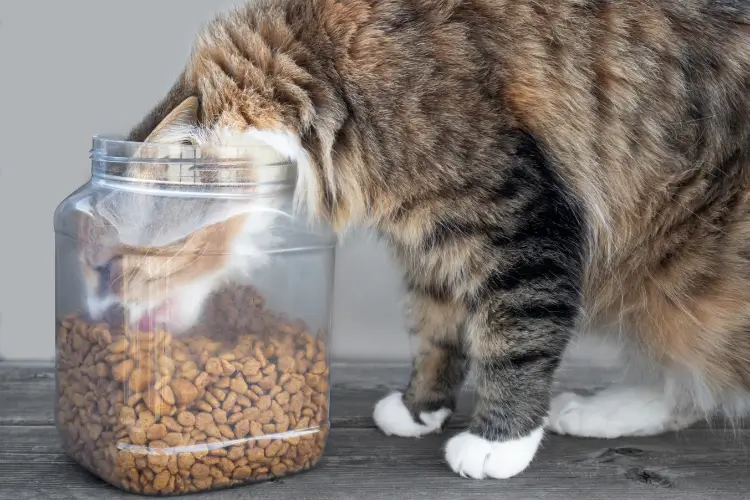Pet owners occasionally find it difficult to make sure their animals consume their kibble. Unwillingness to consume meals might be caused by a pet’s picky eating habits, health problems, or just a general preference for wet food over dry kibble. To encourage pets to routinely eat their kibble, there are a few successful tactics. These are a five-star list of tried-and-true methods that offer fun, interesting, and simple ways to get pets to eat their kibble.
Tips to Help Your Pets Eat Their Kibble
Establish a Consistent Feeding Schedule
Creating a regular feeding plan is one of the best strategies to guarantee that pets consume their food. Just as people, pets too benefit from routine. Providing meals regularly throughout the day fosters eagerness and expectation for mealtimes. This uniformity might lessen the possibility that they will turn up their noses at their meals and aid in controlling their digestive systems. It also stops snacking during the day, which might cause a person to lose interest in eating regular meals. Establish a feeding schedule by calculating the ideal times for your pet’s age, activity level, and overall health. As much as possible, adhere to these times. The pet will eventually come to anticipate meals at these times and be more likely to eat when the kibble is presented.
Create a Positive Feeding Environment
Encouraging pets to consume their kibble requires creating a positive and stress-free feeding environment. Due to their heightened sense of awareness, pets can become less inclined to eat in an unsettling or chaotic atmosphere. Pick a peaceful, low-traffic spot in the house to feed them. Make sure there are no distractions or strong scents in the area that could annoy the pet. Separate dining locations for each pet in the home can help reduce anxiety and competition during mealtimes.
Furthermore, choosing the appropriate kind of bowl might also have an impact. Certain pets seem to fare better with elevated feeders, while others might prefer lower bowls. Try out various combinations to determine which your pet loves, and keep this arrangement consistent.
Gradually Transition to Kibble
When given abrupt dietary changes, pets who are used to a certain kind of food may become resistant. Consequently, a good way to make sure they adjust without any problems is to gradually switch to kibble. Gradually increase the percentage of kibble by adding modest amounts to their current diet over a few days or weeks. This systematic approach minimizes the chance of gastrointestinal distress by giving the pet’s digestive system time to adjust. It also increases the pet’s likelihood of accepting kibble by acquainting it with its flavor and texture. If resistance persists, consider enhancing the kibble’s flavor and scent by adding a tiny bit of warm water or low-sodium broth. Keep an eye on the pet’s eating patterns and general health after they have completely switched to kibble to make sure they are adapting to their new diet and prospering.
Enhance the Flavor and Appeal
Kibble’s texture or flavor might occasionally turn pets off. Pets can find kibble more alluring if its flavor and appearance are improved. Adding moist food or pet-safe meal toppers to the kibble is one method to do this. Their food will become more varied as a result, and it will also taste and smell better overall. To add more nutrition and interest to the kibble, you can also mix in small amounts of cooked veggies, yogurt, or canned pumpkin. A different tactic is to preheat the kibble just before dishing. The food can smell better due to the release of aromas caused by the warmth. Take care not to overheat it, as this can compromise the food’s safety and nutritional content.
Use Interactive Feeding Tools
Pets might find mealtimes to be interesting and intriguing when they use interactive feeding items like slow feeders and puzzle feeders. These gadgets are intended to make animals work for their food, which can spark their curiosity and make them look forward to eating kibble. Pets can get both mental and physical activity from puzzle feeders, which require them to solve a riddle in order to obtain their food. By keeping pets from eating too quickly, slow feeders, on the other hand, can improve digestion and lower the danger of bloat. Automatic feeders are extremely advantageous, particularly for pet owners with hectic schedules. Even when the owner is away from home, the pet can still have regular meals due to an automatic cat feeder for wet food that can be modified to dispense dry kibble. By being consistent, you can assist in creating a habit and lessen the worry that comes with inconsistent feeding times.
Conclusion
Getting pets to eat their kibble can be difficult, but with patience, consistency, and ingenuity, even the pickiest eaters can be encouraged to enjoy their meals. Your pet will be more inclined to eat when food is presented if you establish a regular feeding plan because it will assist in controlling their hunger and digestion. Pet owners can help their pets feel at ease and concentrate on their meals by providing a distraction-free, happy eating environment. The likelihood of digestive distress and resistance is decreased when pets gradually switch to kibble to help them adapt to dietary changes.




